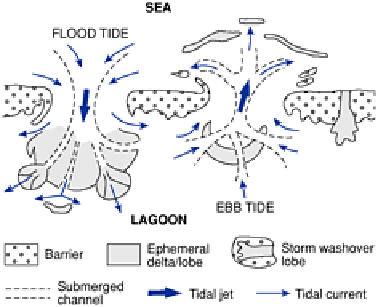Environmental Engineering Reference
In-Depth Information
Figure 17.9
Tidal passes. Separate ebb and flood passes here
develop their own ephemeral deltas and lobes but the same
pass may be used on both ebb and flood tides.
Source: Partly after Carter (1988).
tidal inundation (Plate 17.4).
Puccinellia maritima
(saltmarsh grass),
Spartina
spp. (cord
grass) and
Juncetum
spp. (salt-marsh rush) are the principal members of temperate salt-
marsh communities. The halosere may merge inland with a freshwater hydrosere and
become attractive to reclamation by human intervention. The Ijsselmeer in Holland is the
most celebrated European example. Lagoons are floored by muds, except where tidal
action is strong near passes or they receive terrigenous sediment and sand, blown or
washed over the barrier during storms. Carbonate muds form where biological activity is
intense and lagoons may house
stromatolites
(algal mats) and
bioherms
or prominent
shell beds.
BARRIERS AND BARRIER ISLANDS
Barriers, as their general name suggests, bar advancing waves and buffer or protect the
coastline from wave energy. They line approximately 15 per cent of the global coastline
and assume one or more of four principal forms. Breaking waves and surf create sand or
shingle
beaches
in nearshore and foreshore zones described earlier. Parallel
bars
develop
in the nearshore and offshore zone and
dunes
develop inland of the backshore with good
sand supply and dominant onshore winds. Barriers form at the coastline or offshore as
barrier islands, either by the creation of tidal passes through barriers or by accretion in the
sheltered back-barrier zone behind an offshore bar. Offshore systems can migrate
onshore, initially trapping tidal lagoons behind
barrier islands
or
spits
open at one end,
and eventually merging with the coastline. Biogenic reefs of coral or shells complete the
suite of barriers.
Beach morphology is subject to constant short-term change in response to waves,
tides, winds and sediment fluxes. They may contain several components at any one time
(Figure 17.10). The turbulent nearshore environment segregates sand from gravel which
sustain gentler (2°-8°) and steeper slopes (10°-20°) respectively. These profiles and the

